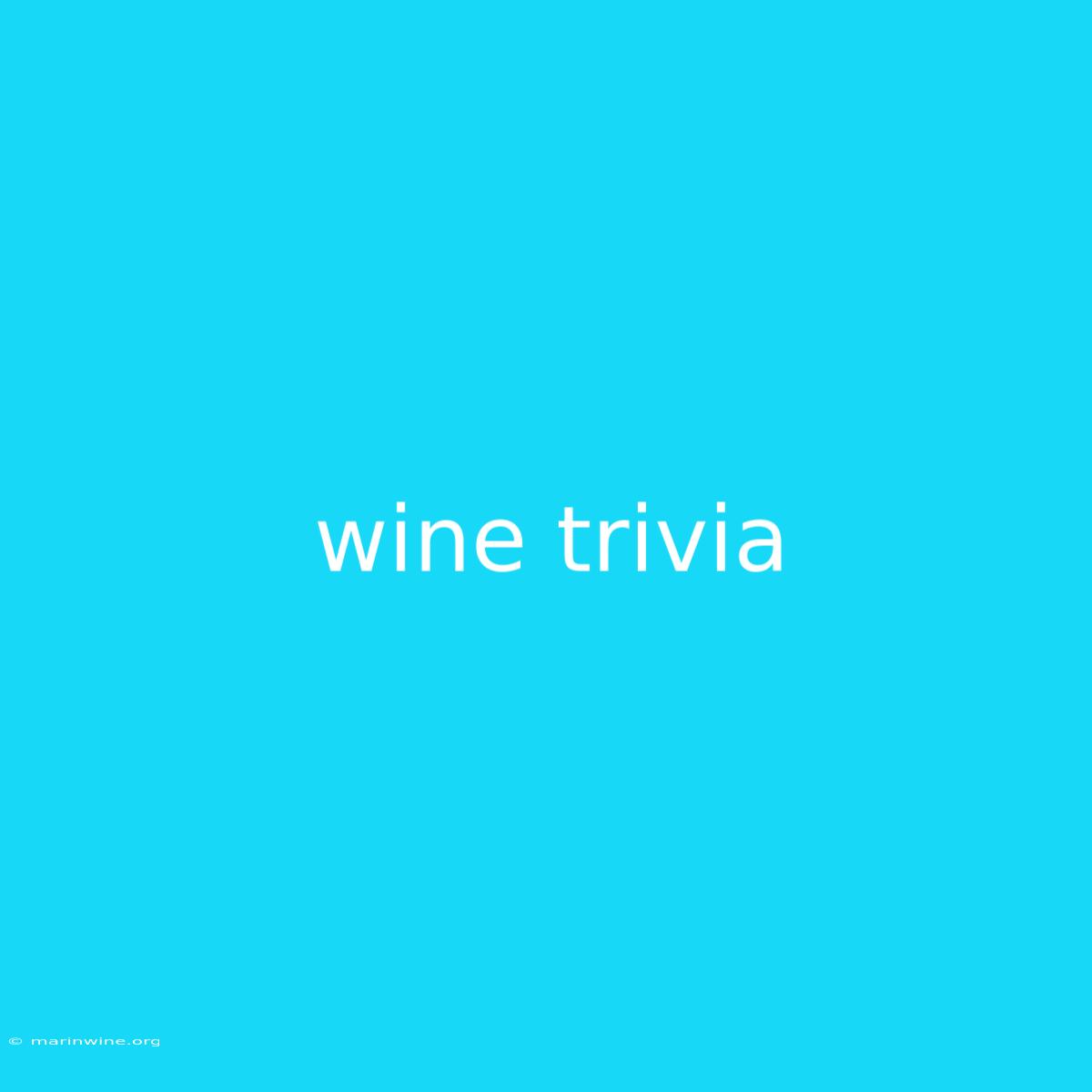Uncorking the Secrets: Wine Trivia That Will Impress Your Friends
Ever wondered what the deal is with all the different types of wine? It’s a fascinating world filled with history, science, and a whole lot of fun facts.
Why It Matters: Wine trivia isn’t just about impressing your friends at a dinner party. It helps you understand the nuances of wine, appreciate its cultural significance, and discover new favorites. Whether you’re a casual sipper or a seasoned sommelier, this knowledge can enhance your wine journey.
Key Takeaways of Wine Trivia:
| Takeaway | Description |
|---|---|
| Wine is made from fermented grape juice | Wine is made by crushing grapes, extracting their juice, and allowing it to ferment with yeast. |
| There are thousands of grape varieties | From Chardonnay and Cabernet Sauvignon to lesser-known gems like Nebbiolo and Syrah, the world of grapes is vast and diverse. |
| Winemaking regions have unique terroir | Soil, climate, and other environmental factors contribute to the distinctive character of wines from a specific region. |
| Wine aging affects its flavor | Time spent in oak barrels or stainless steel tanks influences the complexity and smoothness of a wine. |
| Wine has a rich history and cultural significance | Winemaking dates back thousands of years, and wine plays a vital role in many cultures around the world. |
Wine Trivia: Beyond the Basics
Winemaking Regions:
- Introduction: Winemaking regions are like fingerprints for wine, each contributing a unique signature to its character.
- Facets:
- Terroir: Soil, climate, altitude, and other environmental factors contribute to a region’s unique terroir, influencing grape growth and wine characteristics.
- Examples: Burgundy, Bordeaux, Tuscany, Napa Valley, and Rioja are renowned regions with distinctive terroirs.
- Impacts: Terroir influences the acidity, tannins, fruitiness, and overall flavor profile of the wine.
Wine Styles:
- Introduction: Wine styles range from light and crisp to full-bodied and complex.
- Facets:
- Red Wines: Made from red grapes, often with more tannins and full-bodied flavors.
- White Wines: Made from white grapes, with lighter, more delicate aromas and flavors.
- Rosé Wines: Made from red grapes with short maceration, resulting in a pink hue and a mix of fruit and refreshing acidity.
- Sparkling Wines: Known for their bubbles, they can be made from different grapes and have a range of sweetness levels.
- Summary: Understanding wine styles helps you choose wines that suit your palate and preferences.
Wine Aging:
- Introduction: The aging process is crucial for developing complex flavors and aromas in wine.
- Further Analysis:
- Oak Aging: Wine aged in oak barrels develops notes of vanilla, spice, and toastiness.
- Stainless Steel Aging: Wine aged in stainless steel tanks retains more fruitiness and freshness.
- Time: The length of aging impacts the wine’s complexity and maturity.
- Closing: Wine aging is an art, and the process can significantly alter the character of a wine.
Wine Trivia Table
| Feature | Description | Example |
|---|---|---|
| Wine Region | A geographic area known for producing distinct wines | Bordeaux, France |
| Grape Variety | The specific type of grape used to make the wine | Chardonnay, Cabernet Sauvignon |
| Wine Style | The overall character of the wine, influenced by grape, region, and aging | Dry, fruity, oaked, sparkling |
| Winemaker | The individual or company responsible for crafting the wine | Domaine de la Romanée-Conti |
| Wine Vintage | The year the grapes were harvested | 2019, 2020 |
FAQ
Q: Is wine always alcoholic? A: No, non-alcoholic wines have become increasingly popular. They still have the flavor profile of traditional wines but without the alcohol content.
Q: How do I know if a wine is good? A: There is no single answer to this question. Ultimately, it's about your personal preference. Look for wines that have a balanced acidity, tannins, and fruitiness, and that you enjoy drinking.
Q: What’s the best wine to drink with food? A: Pairing wine with food is a matter of personal preference and can depend on the specific dishes. General guidelines include pairing lighter wines with lighter dishes and fuller-bodied wines with richer foods.
Q: How can I learn more about wine? A: There are many ways to deepen your knowledge of wine. Attend wine tastings, read wine books and articles, take a wine course, or visit wineries.
Q: What are some popular wine trends? A: Natural wines, orange wines, and biodynamic wines are becoming more prevalent, reflecting a growing interest in sustainability and less interventionist winemaking practices.
Q: Can I taste the difference between different wines? A: With practice, you can learn to identify the nuances of flavor and aroma in different wines. Pay attention to the wine’s acidity, tannins, fruitiness, and other characteristics.
Tips for Wine Trivia
1. Taste and Learn: Practice tasting different wines to develop your palate.
2. Region-Specific Knowledge: Familiarize yourself with renowned wine regions and their signature grape varieties.
3. Wine Terminology: Learn key terms like tannins, acidity, and oak aging.
4. Embrace the History: Explore the fascinating history of winemaking and its cultural significance.
5. Ask the Experts: Don't be afraid to ask questions at wine tastings, shops, or online forums.
Summary by Wine Trivia
Exploring the world of wine trivia is a journey of discovery that unlocks a deeper appreciation for this complex and captivating beverage. From understanding winemaking regions to discerning flavor profiles, this knowledge enhances your wine experience.
Closing Message: Next time you're enjoying a glass of wine, remember the secrets it holds and the fascinating stories behind its creation. Keep learning, keep exploring, and keep raising a toast to the world of wine!

